WISE AND NOT SO WISE
/5 Comments/in Gardening, Vegetables/by Lee ReichA lot about this year’s vegetable garden warrants my patting myself on my back; other things warrant a nuggy (virtually impossible unless I was double-jointed). Let’s start with the pat-worthy stuff. Perhaps you’ll find some of it useful in your vegetable garden. Perhaps you’ll want to comment on it.
Good Moves
Sweet corn is one of my favorite vegetables, both fresh in summer, and frozen in winter. Evidently, chipmunks are also fans. I plant sweet corn — the old variety Golden Bantam — in hills (clumps) of three stalks per hill, the hills eighteen inches apart in the row, with two rows running the length of each three-foot-wide bed. I spread out the harvest with four plantings, the first on about the average date of the last frost, mid-May, and the last planting the end of June.
With a variation on traditional corn planting — “one for the rook, one for the crow, one to rot, and one to grow” goes the old saw — I drop five rather than four seeds per hole. 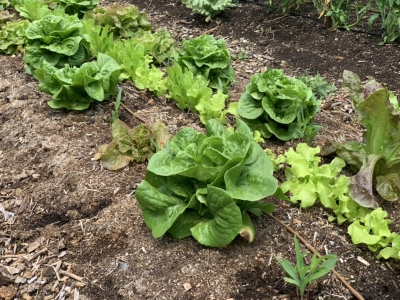 Seed is cheap. Unfortunately, those extra seeds merely gave chipmunks more to eat in that first planting. So . . .
Seed is cheap. Unfortunately, those extra seeds merely gave chipmunks more to eat in that first planting. So . . .
For subsequent plantings I sprinkled a mixture of cayenne pepper and cinnamon over the seeds in each planting hole. Although birds can eat hot pepper, furry animals generally, my dog Daisy excepted, cannot. I figured the chipmunks wouldn’t like the taste of cinnamon and/or it would mask any aroma from the corn seeds. The result: success.
Pests threatening my onions and leeks arrived here on the farmden just a few years ago. Leek moth is one of them and thrips possibly another. Leek moth flies to lay its eggs in early spring, and thrips overwinter in debris. Another pest severely stunted last year’s onions, but neither I nor a university vegetable specialist could find anything odd about the roots, tiny bulbs, or leaves on which to lay blame.
Thoroughly cleaning up debris, which I do for all beds anyway, and covering the bed with fine mesh should keep leek moth, thrips, and possibly other pests at bay. A wire frame to support a large piece of organza fabric, with the organza clothespinned tightly near ground level did the trick. The leeks and onions look healthy and vigorous.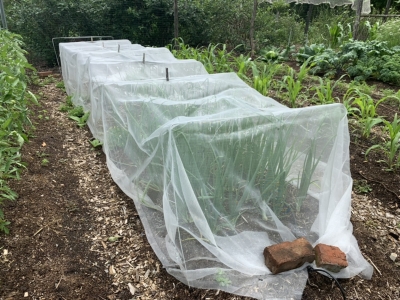
A Successful Makeover
The need for a bold makeover of my south vegetable garden is embarrassing, but I’ll come clean. For some reason I oriented beds in that garden, created in 1997, east and west. I should have know better. It was a more favorable location for the two gates, but that’s not a good excuse. Tall plants in east-west beds shade shorter plants in those and nearby beds throughout the day. So whenever possible, north-south, or nearly north-south, beds are best.
Last fall, with some help from friends, I raked soil in the beds and wood chipped paths as level as possible. (My beds aren’t raised beds, but they do slowly rise after decades of annual slatherings of an inch or more of compost.) 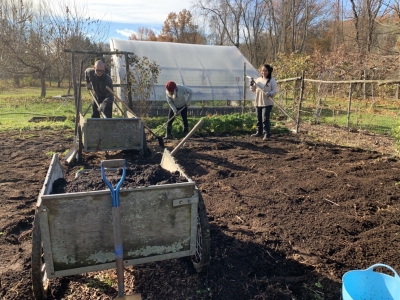 We rolled out gray resin paper to suppress weeds sure to sprout in the newly disturbed soil, then topped the paper with compost in the beds and wood chips in the paths.
We rolled out gray resin paper to suppress weeds sure to sprout in the newly disturbed soil, then topped the paper with compost in the beds and wood chips in the paths.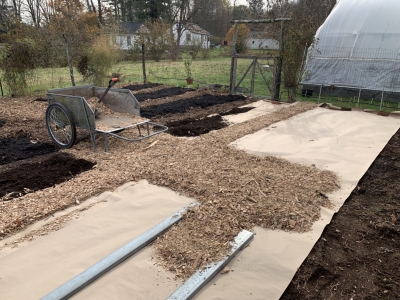
It’s a young garden again! Sort of. When planting, I can feel the difference in the ground from where a bed crosses regions that were once paths versus those that were beds. But the soil will get better every year, and the beds now run the better direction. Only one garden gate now, though.
Everything Not Always Rosy
Not all is always rosy down here on the farmden. Flea beetles, as expected, attacked my eggplants. I could have netted the eggplants also, but I was foolishly banking on hope.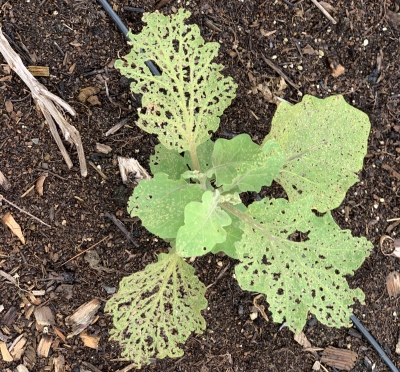 I’ll admit to spraying the organic pesticide Pyganic while waiting for the eggplants to outgrow the damage.
I’ll admit to spraying the organic pesticide Pyganic while waiting for the eggplants to outgrow the damage.
The other pest here is a weed, creeping woodsorrel (Oxalis corniculata). The straight species grows tall and is very easy to weed out. No problem.
The problem child is the purple-leaved variety (Oxalis corniculata var. atropurpurea) which blends in with the soil and hugs the ground in spreading mats. 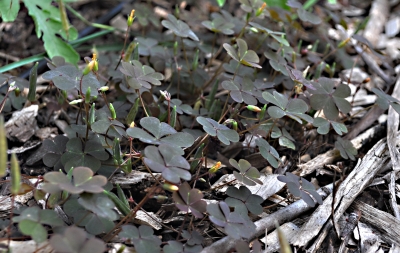 It responds favorably (for me, not it) to sprays of household strength vinegar or any of the other organic herbicides whose active ingredient is ammonium nonanoate, such as Ortho® GroundClear® Weed & Grass Killer or the more benign sounding BioSafe Weed & Grass Killer.
It responds favorably (for me, not it) to sprays of household strength vinegar or any of the other organic herbicides whose active ingredient is ammonium nonanoate, such as Ortho® GroundClear® Weed & Grass Killer or the more benign sounding BioSafe Weed & Grass Killer.
And finally, we come to drip irrigation, a watering technique on which I’ve heaped tons of praise for saving water, for limiting weeds, for healthier plants, and for being easily automated. This last quality can cause a problem. A few years ago I thought a spring had sprung it my field; it was an old main line that was still in line and spewing out water below ground. Another year plants in a couple of beds seemed to languish as drier weather moved in; the underground connection of some drip lines had disconnect from the main line. Yet another time, water was pouring out of an unplugged end of a drip line. Or, last year the battery died on one of the timers; most affected were two small rosemary plants, trained as small trees, many of whose leaves and stems dried up, dead.
This spring, it was, first, the main water source, which is from a shallow well, clogging the filter. And then, a piece of hose running from the well pump to the main line developing a kink.
All these irrigation glitches were easily fixed once I noticed them. And there’s the key. My very smart phone now reminds me to spend the few minutes required to check the drip irrigation system every Monday.
FRUIT VS SHOOT
/0 Comments/in Pruning/by Lee ReichNote 1: I have some plants leftover from this past weekend’s plant sale here at the farmden. Contact me by June 24, 2022 if you’re interested in purchasing to pick up any white currant, black currant, fig, or gooseberry plants (a number of varieties of the latter two).They’re all discounted at 25% off.
Note 2: My farmden is open for a Garden Conservancy Open Day on Saturday, June 18, 2022 from 2 p.m. to 5 p.m. Registration is required, here.
Shoots versus Fruits
I’ve been playing around with the orientation of some of my trees’ branches to influence how they grow. Branches pointed skyward generally are inherently vigorous, giving rise to long shoots, especially from their topmost buds. At the other extreme are branches oriented horizontally. They’re generally weak-growing, and tend to produce fruit buds rather than vigorous shoots and leaves. The cool thing is that if you or I change branch orientation, it changes the growth and fruiting habit of that branch.
Bending and tying branches is a good way to balance shoot growth and fruiting, especially of apple and pear trees. Both types of growth are needed. The fruits for us to eat, and the shoots to “feed” the fruit and to provide places on which to hang the fruits. Shoot growth is also needed to periodically replace old wood.
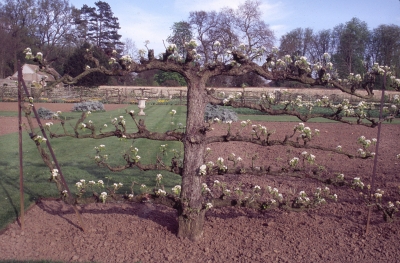 Branch bending to regulate growth and fruiting is especially evident with an espalier, which is a tree grown in an orderly, usually two dimensional form. Lurking behind the many forms, fanciful and otherwise, for espaliers is an appreciation for their effects on growth and fruiting.
Branch bending to regulate growth and fruiting is especially evident with an espalier, which is a tree grown in an orderly, usually two dimensional form. Lurking behind the many forms, fanciful and otherwise, for espaliers is an appreciation for their effects on growth and fruiting.
Achieving Balance
Backyard apple and pear trees commonly put too much of their energy into shoot growth, a problem that can be exacerbated by overly enthusiastic pruning and over-fertilization. One way to coax an overly vigorous tree into bearing is by pulling upright branches downward, affixing them in that direction. This may seem an unnatural way to treat a plant, but it does help a tree to get started fruiting. Once fruiting begins, the weight of the fruit will keep branches down.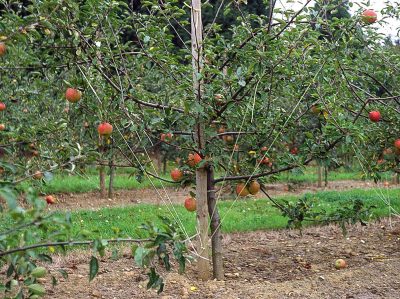
Sometimes fruit pulls a branch down so much that it’s too fruitful and needs invigoration. Asian pears are prone to bearing too heavily too early in their life, especially if grafted on dwarfing rootstocks; the result is a stunted tree. The cure is to drastically cut drooping branches back to more upward growing — and, hence, vigorous — side shoots. Or to stake branches into more upright positions.
Bending down branches spreads them, which, along with correct pruning, also lets all branches bathe in sunlight. With many upright growing branches, the interior of a tree becomes too shaded to produce fruit buds or even leaves. 
Branches that are spread at an early age make wide angles with the trunk. That wide angle attachment becomes a strong juncture, one that will not break when eventually weighted down with fruit, as often occurs with branches having narrow crotch angles.
Practical Matters: How to Do It
On very young trees which are still forming their main branches around the trunk, I start spreading the new shoots when they are just a few inches long. After bending a shoot carefully so as not to break it, I hold it in that position by snapping a spring-type clothespin on the trunk with the tail of the clothespin holding the shoot down.  Another way to hold this wide angle is to press one end of a toothpick into the shoot and the other into the trunk, just enough to keep the toothpick in place.
Another way to hold this wide angle is to press one end of a toothpick into the shoot and the other into the trunk, just enough to keep the toothpick in place.
For older branches, I use either a stiff wire or a length of wood with a brad driven in each end. (I’ve previously removed the brad’s head and sharpened what remains.) 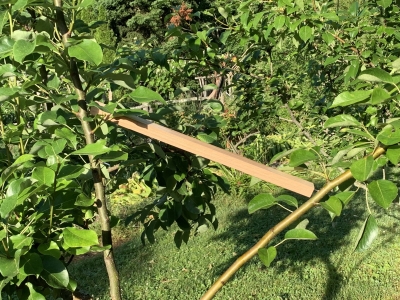 Tying a string around a branch, and then to a weight on the ground or to the tree’s trunk is another way to pull a branch down. Or, you can affix a weight right to the branch. For instance, glue a clothespin to a rock, then clip it to the branch.
Tying a string around a branch, and then to a weight on the ground or to the tree’s trunk is another way to pull a branch down. Or, you can affix a weight right to the branch. For instance, glue a clothespin to a rock, then clip it to the branch.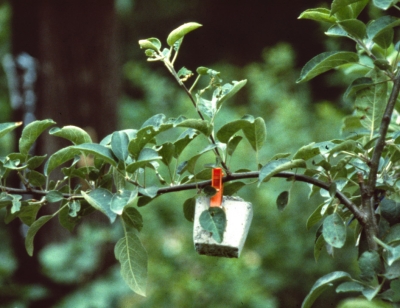
After a few weeks, the ties or weights or clothespins can be removed. The branches will stay in place.
Ideally, re-orienting the branches of apple and pear trees achieves a favorable balance between shoots and fruits. To this end, strive for about a sixty degree angle to the trunk. I try to keep the branch straight as it is oriented to this angle. If the branch has a bow in it when pulled down, overly vigorous shoots are apt to grow from buds at the topmost part of the bow.
Don’t expect immediate payback for all this care and effort. A year or more might elapse before an apple or a pear tree forms fruit buds, and fruit buds form fruit buds the season prior to actual fruit production. It’s worth the effort in the long term.
PLANT SALE, PLANT LIST
/8 Comments/in Gardening/by Lee ReichPlant Sale
•This year the 14th(?) Annual Plant Sale will be held live, here at Springtown Farmden in New Paltz, NY.
•Plants, available in limited quantities
•Here’s a not necessarily complete list of what’s available (pricing not yet determined):
APPLE (Redfree)
BLUEBERRY (lowbush, Berkeley highbush)
BLACK CURRANT (Belaruskaja, Titania)
RED/WHITE CURRANT (Red Lake, Primus)
FIGS (Sicilian, LSU Purple, Brown Turkey, Rabbi Samuel, San Piero, Unknown)
GOOSEBERRY (Captivator, Chief, Glendale, Poorman, Red Jacket
GARLIC CHIVES
GRAPE (Glenora, Brianna)
HARDY KIWIFRUIT (2 species)
HARDY ORANGE (Poncirus trifoliata)
HAZELNUTS (blight resistant Somerset, Raritan)
HELLEBORE
MEDLAR (Breda Giant, Puciu Mol)
NANKING CHERRY
PEAR (Asian Tsu Li, European Harrow Delight)
PULMONARIA
SWEET WOODRUFF
TOMATOES (heirloom varieties Valencia, Nepal, Pink Brandywine)
WILD GINGER
This year, there’ll also be lots of books (in addition to the ones I wrote), some for sale and some free. The books cover a wide range of gardening topics.
Date and Time: June 12, 2022, 9:30 AM – 1:00 PM
Location: Springtown Farmden in New Paltz, NY
•Parking is available on the street, in the two driveways at the sale, and at the DEC boat launch a few hundred feet north on the opposite side of the street.
•To prevent overcrowding with cars or people, please plan on staying no longer than 15-30 minutes. Thank you.
•You must be (correctly) masked to attend this live sale, Again, thank you.



